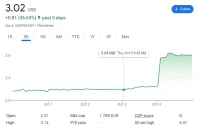Okay, let's talk FIRO. It's making noise again, with talk of hard forks and price surges. The question is: can this rally actually last, or is it just another flash in the pan fueled by hype? I'm seeing a lot of excitement about privacy coins in general, and FIRO specifically, but I'm always skeptical until the data backs it up.
The Hard Fork Hype
FIRO is touting its upcoming hard fork, scheduled for November 19, 2025. The upgrades include Spark Name transfers and reduced GPU VRAM requirements for mining. The stated idea is that this will encourage more network activity. But will it really translate into sustained price action?
The data shows that FIRO has already delivered a significant pump, around 747% over the last 90 days. The coin is currently hovering around $4.42. Some analysts are predicting it could reach $9 before the end of 2025. That's a bold claim.
One argument is that FIRO broke a four-year wedge pattern, signaling a long-term bullish structure. That's interesting, but technical analysis alone isn't enough. You need fundamental drivers. The hard fork is supposed to be one, but I'm not entirely convinced.
The upgrade to version 0.14.15.0 is expected to enable Spark Name transfers. Previously, Spark names were only used for wallet identification. Now, they'll become tradable assets. The Firo team believes this increases liquidity and encourages community participation. But, is there really a robust use case for these Spark Names? Are people actually going to use them, or is it just another speculative asset?
And while reducing GPU VRAM requirements sounds good (allowing 8GB GPUs to mine), is that really a barrier to entry that's holding FIRO back? I suspect not. I think the limiting factor is more about overall adoption and regulatory uncertainty.
The Privacy Coin Paradox
The overall narrative around privacy coins is certainly helping FIRO. The sector saw an average gain of 320%, according to Artemis. Some investors are even comparing FIRO's trajectory to Zcash (ZEC). Someone even said, "Buying FIRO at $5.3 is like buying ZEC at $5.3." That's a dangerous comparison.

Here's why: privacy coins are inherently volatile due to regulatory pressure. Governments don't like them because they make it harder to track illicit activity. That's a constant headwind that FIRO has to contend with. Past delistings have definitely dented liquidity.
Moreover, FIRO's fate seems closely tied to ZEC's trend. If ZEC tanks, FIRO will likely follow. And there are warnings that ZEC may be forming a new bubble pattern.
And this is the part of the report that I find genuinely puzzling: on-chain data shows that the top 10 richest wallets control more than 39%—to be more exact, 39.x%—of FIRO's total supply. These wallets have been dormant for years, accumulating FIRO at low prices. Now that the price is above $5, these holders are sitting on profits. What happens when they decide to cash out? A large-scale sell-off could easily trigger a major correction.
The launch of Spark Assets, which allows developers to mint privacy-first tokens, is another potential catalyst. The idea is that this will convert Firo from a stand-alone privacy coin into a privacy infrastructure layer. Early metrics do show rising daily active addresses and higher transaction volumes. But, it's still early days. We need to see if this trend continues.
Technically, FIRO faces resistance near $3, a level that has capped rallies since mid-2022. Momentum indicators are still positive, but there's also bearish divergence on the daily chart. A failed breakout could lead to a correction toward the $1.47–$1.84 zone.
Ultimately, the success of FIRO depends on the adoption of Spark Assets. If it attracts cross-chain activity, FIRO may see steady demand. But, a failed test and weaker liquidity could prompt deeper pullbacks.
A House Built on Sand?
Look, FIRO has made some impressive gains recently. The hard fork has generated some buzz, and the privacy coin narrative is certainly helping. But, there are too many red flags for me to be truly bullish. The concentrated ownership, regulatory risks, and dependence on ZEC's trend all make me nervous. I'm not saying FIRO is doomed, but I'm definitely not convinced that this rally is sustainable. Show me real-world utility and decreased concentration of ownership, then we can talk.










